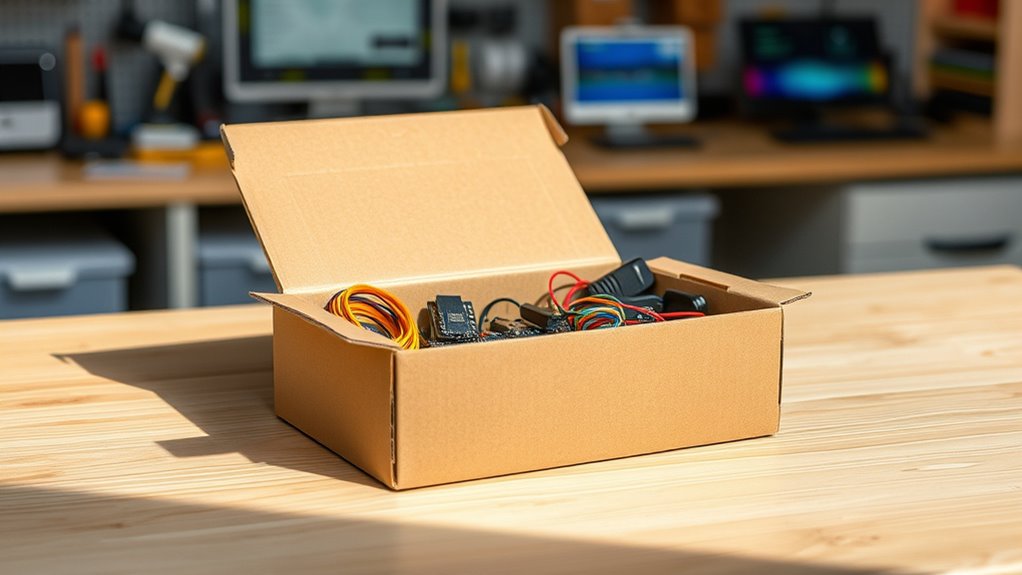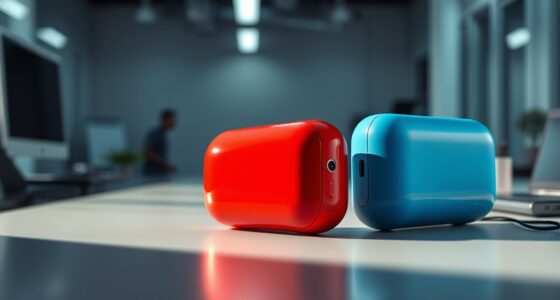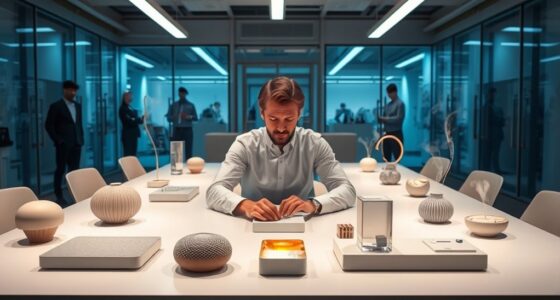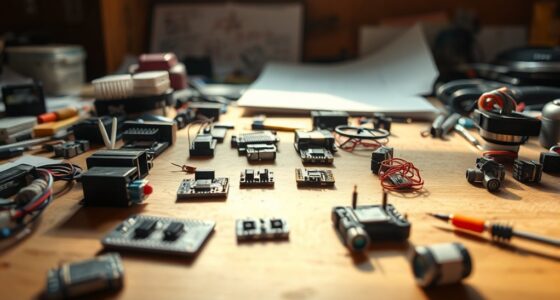Remote prototyping kits, or discovery boxes, help you design, test, and refine prototypes from afar. They include physical components like sensors and modular parts, along with digital tools such as VR, AR, or 3D printing. Shipping these kits allows teams to collaborate hands-on across distances, gather user feedback, and accelerate development. If you want to explore the best ways to implement and optimize these kits, there’s more to discover below.
Key Takeaways
- Remote prototyping kits enable virtual collaboration by shipping curated hardware components for testing and iteration across dispersed teams.
- They include versatile, easy-to-use tools like sensors, electronics, and instructional guides to streamline rapid development.
- Shipping logistics involve customs documentation, reliable couriers, and precise labeling to ensure timely delivery of discovery boxes.
- Effective remote discovery uses real-time video, screen sharing, and tailored kits that consider user context for meaningful feedback.
- Advanced tech like AR, AI, and 3D printing enhances remote prototyping, enabling immersive visualization and rapid physical model creation.
What Are Remote Prototyping Kits and How Do They Work
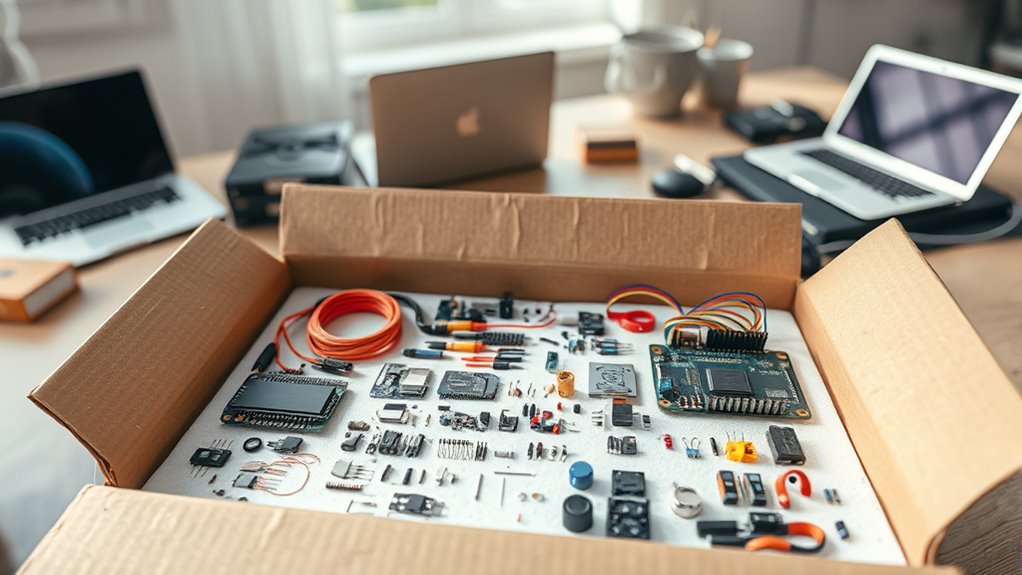
Remote prototyping kits are tools that enable you to design, test, and refine prototypes without being physically present in the same location as your team or testing subjects. They often incorporate virtual reality, allowing you to create immersive environments for better testing and feedback. Hardware integration is a key feature, connecting physical components with digital interfaces to simulate real-world interactions. You can manipulate hardware setups remotely, gather user responses, and make adjustments in real-time. These kits typically include sensors, controllers, and VR headsets, which work together to bridge the gap between physical and virtual. This seamless integration helps you evaluate product functionality and user experience more efficiently, all while working from different locations. Understanding spiritual energy as a subtle force can also inspire innovative ways to enhance user engagement and emotional connection in design. It’s a powerful way to accelerate development and refine designs faster.
Benefits of Using Remote Prototyping for Product Development

Using remote prototyping tools offers significant advantages in product development, streamlining processes and expanding possibilities. They enable you to engage in virtual collaboration, allowing team members across different locations to contribute ideas, review designs, and make adjustments in real time. This approach reduces delays caused by physical handoffs and accelerates decision-making. Additionally, remote prototyping enhances prototype customization, giving you the flexibility to easily modify designs based on feedback without waiting for physical models. You can test concepts more efficiently and gather diverse insights quickly. Overall, these tools foster a more agile development process, saving time and costs while improving the quality of your final product. They make collaboration seamless, ensuring your team stays aligned and productive throughout the entire development cycle. Cookies can play a role in optimizing user experience during online collaboration by tracking engagement and preferences.
Key Components Included in a Typical Discovery Box

A typical discovery box includes a carefully curated selection of tools and materials designed to kickstart your prototyping process. You’ll find versatile components that enable prototype customization, allowing you to adapt designs quickly without starting from scratch. These might include basic electronics, sensors, and modular parts suited for your project’s needs. To keep shipping costs manageable, the box emphasizes lightweight, compact items that provide maximum value. You’ll also receive instructional guides and sample materials to help you understand how each component works together. This setup allows you to experiment, iterate, and refine your prototype efficiently. Additionally, including essential components related to your project’s goals can streamline your development process and enhance functionality. With these key components, you can explore different configurations without the hassle of sourcing individual parts, making remote prototyping more accessible and cost-effective.
How Remote Kits Enhance Collaboration Across Teams
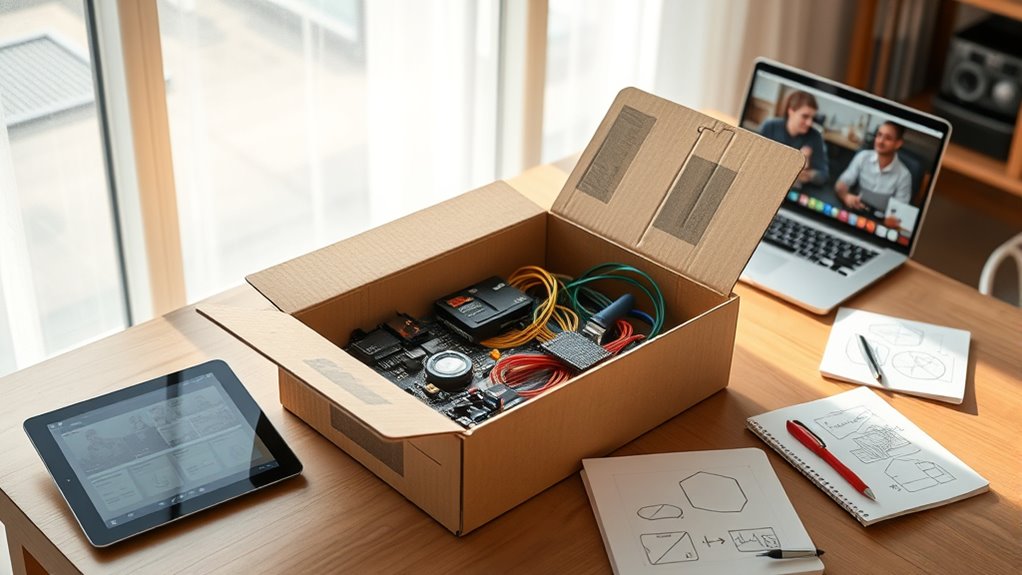
Have you ever wondered how teams separated by distance can collaborate seamlessly on innovative projects? Remote prototyping kits make this possible by fostering virtual collaboration and streamlining remote design efforts. These kits provide everyone with the same tangible tools, so team members can share ideas, give instant feedback, and iterate quickly—regardless of location. They break down geographical barriers, allowing cross-functional teams to work as if they’re in the same room. With remote kits, you can visualize concepts, test prototypes, and refine designs collaboratively, boosting efficiency and creativity. This shared experience promotes a deeper understanding of user needs and encourages real-time problem-solving. Additionally, integrating familiar Ice Cream Recipes into team-building activities can enhance bonding and creativity during remote sessions. Ultimately, remote kits transform the way teams work together, making collaboration more dynamic and effective across distances.
Strategies for Effective User Testing With Remote Prototyping

To get meaningful feedback, you need clear testing guidelines that everyone understands. Facilitating real-time interactions allows you to observe user reactions and clarify issues instantly. Additionally, emphasizing color accuracy in your prototypes can help identify visual discrepancies early on, ensuring the final product meets user expectations. Together, these strategies ensure your remote testing is effective and yields valuable insights.
Clear Testing Guidelines
How can you guarantee your remote user testing yields reliable and actionable insights? Clear testing guidelines are essential. Start by defining specific goals and tasks for participants, ensuring they understand what to focus on. Use remote testing to gather honest feedback, but avoid ambiguity by customizing your kit to match user contexts. Kit customization ensures users can engage naturally, reducing confusion. Provide detailed instructions, including step-by-step procedures and expected outcomes. Share these guidelines upfront and confirm understanding before testing begins. Clear instructions minimize misinterpretations and help participants perform tasks consistently. Remember, well-structured guidelines foster reliable data and meaningful insights. Understanding symbolism in dream interpretation can help clarify confusing or ambiguous feedback. Consistency in testing procedures across users is key to identifying genuine usability issues, making your remote testing more effective and your findings more valuable.
Facilitate Real-Time Interaction
Engaging users through real-time interaction is crucial for uncovering authentic usability issues during remote testing. By leveraging virtual collaboration tools, you can observe user behaviors directly and gather immediate feedback. This approach fosters a more natural testing environment, improving remote usability insights. Use video calls and screen sharing to facilitate seamless communication, allowing you to clarify tasks and answer questions instantly. Encourage users to verbalize their thoughts, making their decision-making process transparent. Incorporate live annotations or co-design sessions to highlight problem areas and brainstorm solutions collaboratively. Real-time interaction helps you identify pain points swiftly, adapt testing protocols on the fly, and build a more accurate understanding of user needs—all within a remote setup. This strategy ensures your remote prototyping process is both effective and insightful.
Overcoming Challenges in Remote Prototype Deployment
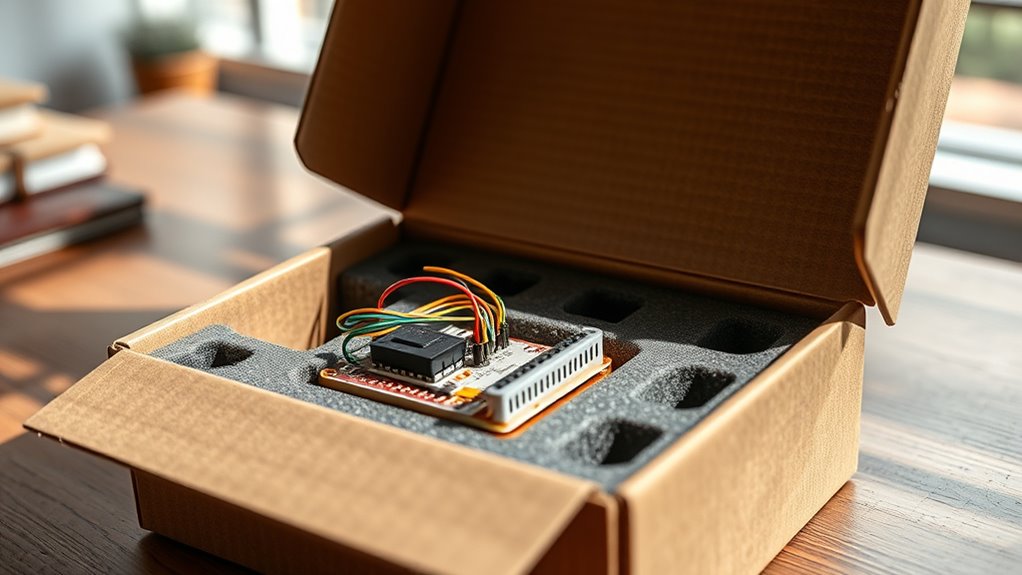
You’ll need to address device compatibility to guarantee your prototypes work seamlessly across different hardware and operating systems. Managing shipping logistics is also essential to deliver kits reliably and on time. Tackling these challenges upfront helps you deploy your prototypes smoothly and gather valuable user feedback. Incorporating user-centered design principles can further ensure the prototypes meet actual user needs and expectations.
Ensuring Device Compatibility
Ensuring device compatibility is a critical challenge when deploying remote prototypes, as it requires addressing the diverse range of hardware and software configurations users may have. You need to guarantee that your prototype can smoothly integrate with various hardware setups, which involves thorough hardware integration testing. Compatibility issues can lead to frustrated users and unreliable feedback, so it’s essential to design flexible solutions that work across multiple devices and operating systems. You might consider providing clear specifications and minimum requirements, or developing adaptable software that can auto-detect and adjust to different hardware environments. Additionally, understanding suction power and filtration systems can help you optimize hardware compatibility and ensure your prototype performs reliably across different setups. By proactively managing device compatibility, you reduce technical barriers, streamline the user experience, and improve the overall success of your remote prototyping efforts.
Managing Shipping Logistics
How can you navigate the complexities of shipping logistics when deploying remote prototypes? Start by carefully preparing shipping labels to guarantee accurate delivery. Double-check addresses and include clear handling instructions. Customs documentation is vital; provide detailed descriptions, proper valuations, and all required forms to prevent delays or confiscation. Be aware of international shipping restrictions and regulations that could add complications. Partner with reliable couriers experienced in handling technical equipment. Track shipments regularly and maintain open communication with carriers to resolve issues quickly. Planning ahead for potential delays or customs issues helps keep the process smooth. Ensuring you understand shipping regulations and compliance requirements will help prevent unforeseen obstacles. By paying close attention to shipping labels and customs documentation, you minimize disruptions, ensuring your remote prototypes arrive safely and on time.
Case Studies: Successful Remote Prototyping Initiatives
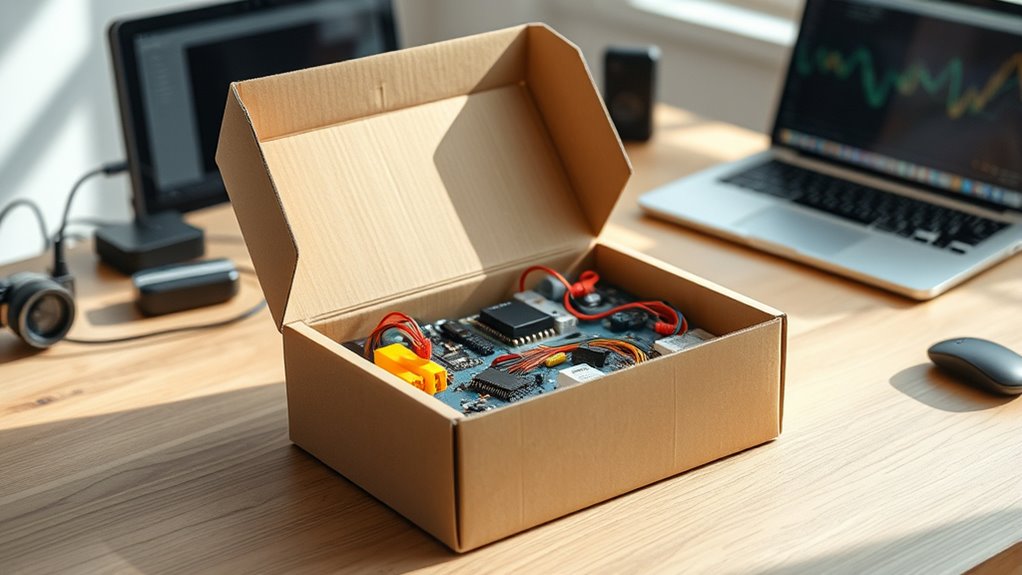
Remote prototyping initiatives have gained significant traction as organizations seek efficient ways to innovate without physical presence. One success story involves a consumer electronics company that used remote kits to facilitate virtual collaboration across global teams. By shipping customized prototypes directly to participants, they enabled real-time feedback and iterative improvements. This approach allowed designers to quickly adapt features through prototype customization, reducing development cycles. Another example is a healthcare startup that employed remote prototyping to test device ergonomics with diverse user groups from different locations. The ability to gather insights virtually helped them tailor prototypes to specific needs, accelerating product readiness. These initiatives demonstrate that, with strategic planning, remote prototyping can foster innovation, streamline collaboration, and deliver customized solutions without the constraints of physical proximity.
Tools and Platforms Supporting Remote Prototype Sharing
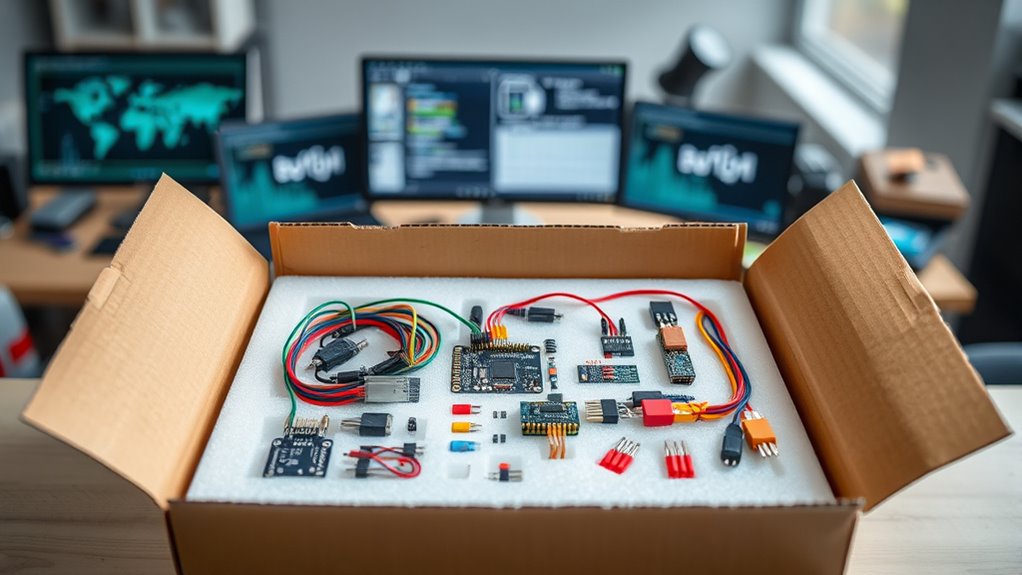
A variety of tools and platforms now make remote prototype sharing more efficient and accessible, enabling teams to collaborate seamlessly regardless of location. These solutions foster virtual collaboration by allowing real-time feedback, screen sharing, and interactive walkthroughs. Platforms like Figma, InVision, and Miro provide cloud-based environments where team members can view, comment, and iterate on prototypes simultaneously. They also support remote onboarding, helping new team members quickly understand design intent and functionality without physical presence. These tools often integrate with project management systems, streamlining workflows and keeping everyone aligned. By leveraging these platforms, you can guarantee that your remote prototyping process remains dynamic, inclusive, and productive—no matter where your team is located.
Best Practices for Analyzing User Feedback Remotely
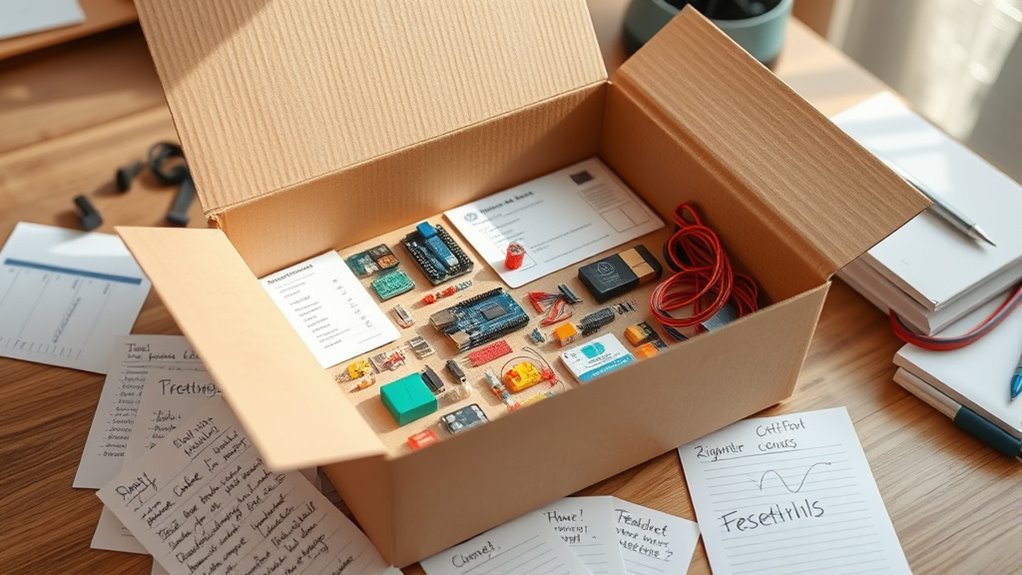
To effectively analyze user feedback remotely, you need to focus on gathering observational data that highlights how users interact with your prototype. Identifying common challenges they face allows you to pinpoint areas for improvement. By implementing iterative changes based on this feedback, you can continuously enhance your design and better meet user needs.
Gather Observational Data
How can you effectively analyze user feedback collected remotely? The key is to gather observational data that reveals genuine user interactions. Guarantee your prototyping kits have reliable wireless connectivity so you can monitor real-time activity without interruptions. Use video recordings or screen-sharing to observe how users navigate your hardware, noting areas where hardware customization impacts usability. Pay attention to subtle cues like hesitation or frustration, which often highlight underlying issues. Combining direct observations with user comments helps you identify patterns and pain points. Keep your focus on what users are doing, not just what they say. This approach provides deeper insights, allowing you to iterate more effectively and tailor hardware features to actual user needs.
Identify User Challenges
When analyzing user feedback remotely, pinpointing specific challenges requires a structured approach. Start by categorizing the feedback into common themes, noting recurring issues related to usability or functionality. Pay close attention to concerns about user privacy, guaranteeing users feel secure sharing honest insights. It’s also essential to evaluate comments related to prototype security, as doubts here can hinder honest feedback and trust. Use surveys, interviews, and digital annotations to gather detailed insights. Be transparent about how data will be handled to protect user privacy. Recognize patterns indicating friction points or misunderstandings. Addressing these challenges early helps you refine your prototype effectively while maintaining user trust and safeguarding their privacy. This disciplined analysis ensures meaningful improvements without compromising security.
Implement Iterative Changes
Implementing iterative changes based on remote user feedback requires a disciplined approach to guarantee continuous improvement. Start by analyzing insights gathered through remote testing, focusing on patterns and recurring issues. Use virtual collaboration tools to share findings with your team quickly, ensuring everyone stays aligned. Prioritize changes that address core user challenges identified during testing, and implement updates systematically. Communicate clearly with remote testers about upcoming adjustments to keep their engagement high. After making changes, conduct follow-up testing to verify improvements and gather fresh feedback. This cycle of continuous refinement depends on clear documentation and open communication channels. By embracing virtual collaboration and maintaining a structured process, you ensure your design evolves effectively, ultimately creating a more user-centered product.
Future Trends in Remote Prototyping Technology
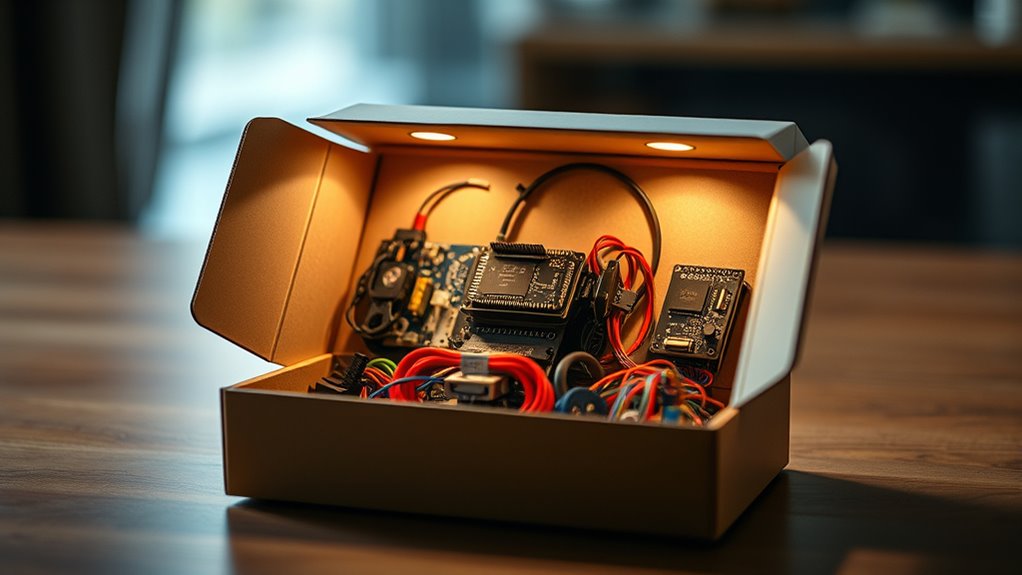
As remote prototyping technology continues to evolve, we can expect significant advancements driven by artificial intelligence, augmented reality, and improved connectivity. Augmented reality will become more integrated, allowing you to visualize and manipulate prototypes in real-time within your environment, enhancing design accuracy. 3D printing will play a bigger role, enabling you to produce physical models quickly and on-demand, reducing lead times. AI will streamline decision-making by analyzing data and suggesting design improvements effortlessly. Improved connectivity guarantees seamless collaboration across distances, making remote prototyping more efficient and accessible. These trends will empower you to iterate faster, reduce costs, and innovate more effectively, transforming the way you develop prototypes without physical boundaries.
Frequently Asked Questions
How Secure Is the Data Shared Through Remote Prototyping Kits?
You might wonder how secure your data is when sharing through remote prototyping kits. Rest assured, most kits use data encryption to protect your information during transmission. Access controls further limit who can view or modify your data, adding an extra layer of security. While no system is entirely invulnerable, these features substantially reduce risks, ensuring your shared data stays private and protected throughout your prototyping process.
Can Remote Kits Accommodate Hardware and Software Testing Simultaneously?
You can definitely find remote prototyping kits that support simultaneous hardware integration and software testing. These kits are designed to enhance user experience by allowing you to test hardware and software together in real-time. They typically include features for easy hardware setup and software updates, ensuring smooth coordination. This integrated approach streamlines your development process, giving you a thorough view of how your product performs under real-world conditions.
What Is the Average Turnaround Time for Prototype Delivery?
You’re wondering about the average turnaround time for prototype delivery. Typically, production timelines depend on shipping logistics, complexity, and customization. Most companies aim for 1 to 4 weeks, but delays can occur due to shipping or production issues. Efficient planning and clear communication help guarantee your prototypes arrive promptly, allowing you to stay on schedule and make necessary adjustments without disrupting your project timeline.
Are Remote Prototyping Kits Suitable for Highly Specialized or Niche Industries?
This might be the most important question you’ll ask today. Remote prototyping kits can be highly effective, but their suitability depends on your industry’s need for customization and niche applicability. If your field requires specialized components or unique specifications, you’ll want to guarantee the kit offers enough flexibility. While they work well for many sectors, highly specialized or niche industries may need tailored solutions to truly meet their complex requirements.
How Do Remote Kits Support Iterative Design Processes Effectively?
You can see how remote kits support iterative design by fostering collaborative workflows. They allow you to test and refine prototypes quickly, even from afar. With remote feedback channels built into the process, you get real-time insights that help you adapt your designs efficiently. This ongoing cycle of testing and improvement enhances your project’s flexibility, ensuring your team stays aligned and responsive throughout the development journey.
Conclusion
As remote prototyping kits continue to evolve, the possibilities for innovative discovery are expanding faster than ever. Will these tools reshape how you approach product development and user feedback? The future holds exciting innovations that could change everything—if you stay ahead of the curve. Are you ready to open new levels of collaboration and insight? The next breakthrough might be just a kit away—are you prepared to discover it?
